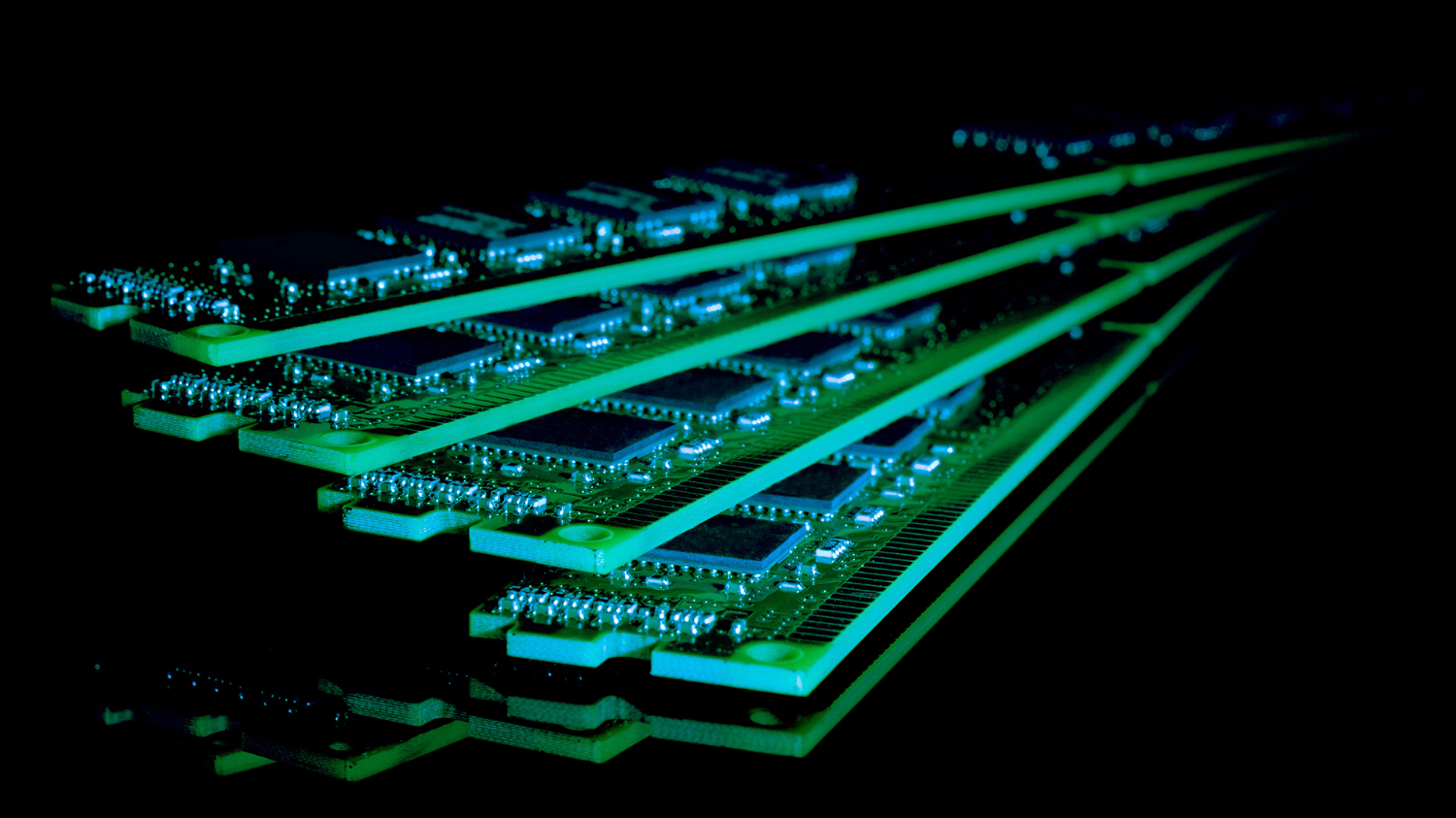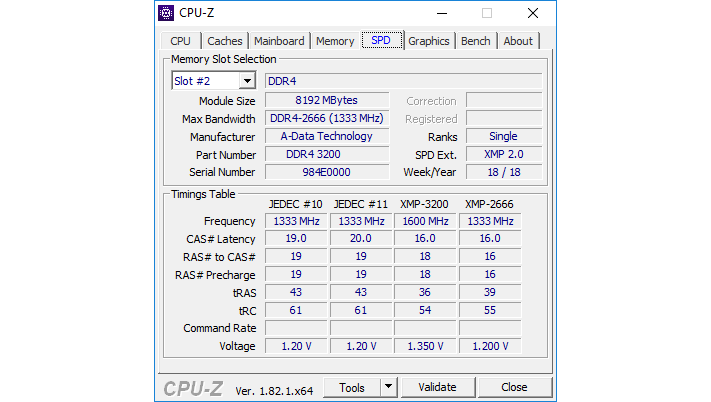Simple RAM Overclocking With a Few Clicks: How to Enable XMP
Intel XMP is an automated overclocking technology that enables motherboards to configure memory settings above and beyond the basic rated speeds of the PC industry, which are often significantly slower than the speeds that are actually achievable with a few clicks and compatible hardware.
New PC builders and upgraders without experience with XMP often wonder why their memory doesn't run at its advertised speed or data rate. High-speed memory that operates outside of industry standard specifications doesn’t get automatically configured when plugged into most systems. Realizing that most users won't manually overclock their memory to reach its rated above-standard rating, Intel developed an extended configuration table that’s stored on each compatible memory module’s EEPROM (a tiny flash storage chip), alongside the industry-standard settings which the memory will usually default to when first installed.
The information contained within this table extension is called an Extreme Memory Profile (XMP), and it includes such things as higher-than standard speed (data rate), lower-than-standard response time (latency), and any additional voltage needed to make the memory stable at these higher settings. Shown above is a CPU-Z screen shot (see how to take screenshots in Windows) of the configuration reading from a set of memory that supports both an increased data rate (DDR4-3200) and a decreased latency set (DDR4-2666 C15). Based upon DDR4-2666 C17 integrated curcuits (ICs), this kit needs the motherboard to increase its DIMM voltage from 1.20V to 1.35V to run reliably at its highest XMP data rate.
How Do I Enable XMP?
XMP mode is a firmware (UEFI) setting for compatible boards, which usually means that users must enter their firmware’s UEFI or BIOS and either click an icon or select XMP from a menu. Each motherboard brand develops its own UEFI interface, and users are often required to enter an overclocking menu. Entering UEFI is usually as easy (or as difficult) as tapping the Delete key during system initialization, before the OS begins to load. Some motherboards use other keys, such as F2, and some users are forced to tap the correct key in rapid succession after powering on simply to catch the short window between firmware and OS initialization. If need be, consult your motherboard or system manual for details about how to access the UEFI/BIOS.
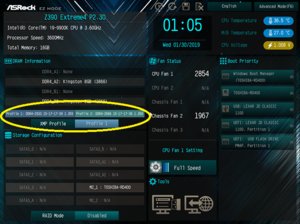
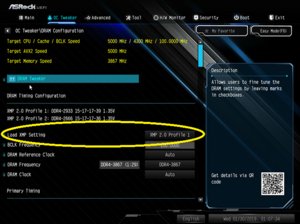
ASRock motherboards, for example often include both an Easy and Advanced graphical user interface (GUI). XMP, being a fairly simple overclocking process, is present on the main screen of they company's easy interface, and also within the DRAM Configuration submenu of its OC Tweaker menu in Advanced Mode.
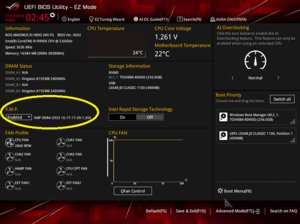
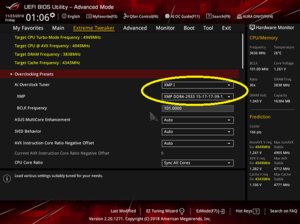
Asus also offers XMP in its easy GUI, but it’s the baseline setting for CPU overclocking within the Extreme Tweaker menu of Advanced Mode.
Get Tom's Hardware's best news and in-depth reviews, straight to your inbox.
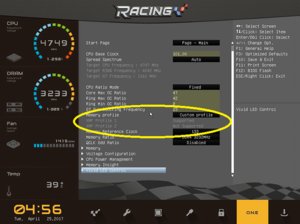
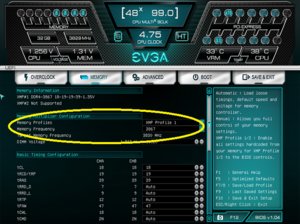
Biostar’s XMP selection is found within its O.N.E. (Overclocking Navigator Engine) menu, and EVGA’s within its Memory menu.
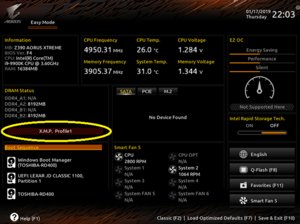
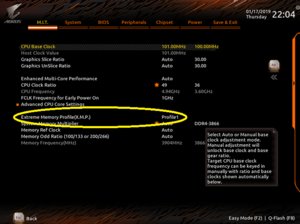
Gigabyte’s Easy Mode offers one-click XMP. This setting is also available within both the Advanced Frequency Settings and Advanced Memory Settings submenus of its Advanced Mode M.I.T. (Motherboard Intelligent Tweaker) menu.
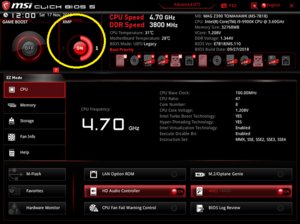
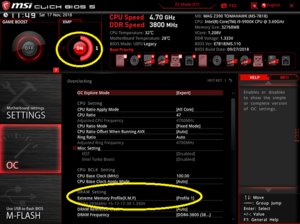
MSI’s easy XMP button (the icon circled in the images above) persists through both its easy and advanced GUI, with a secondary setting made available to overclockers in Advanced Mode.
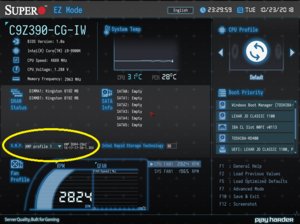
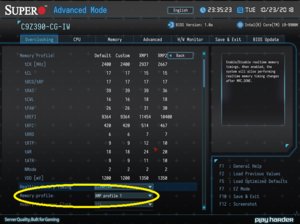
Supermicro’s consumer boards offer an XMP setting on the single-page EZ Mode menu, as well as the Memory Overclocking submenu of its Overclocking menu within Advanced Mode.
Exceptions, Exemptions, And Limitations
A member of the industry that develops manufacturer-agnostic memory standards, AMD's hardware doesn't always support Intel's nonstandard XMP settings. Major motherboard brands have attempted to reconcile AMD’s increased latency by adding a few cycles to the various timings specified in XMP. Asus calls this compromise D.O.C.P., and MSI calls it A-XMP: Builders should pay careful attention to our findings for each board in our reviews, since no two AMD boards produce identical maximums. If you’re looking for generalizations, most X470 motherboards will support at least DDR4-3467 when paired to a Ryzen 7 2700X. Most lesser chipsets and CPUs will work with at least DDR4-2933, and there’s a great number of products that fit between these minimal maximums.
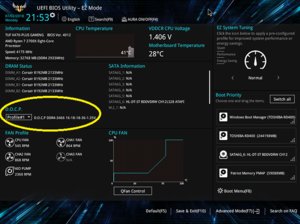
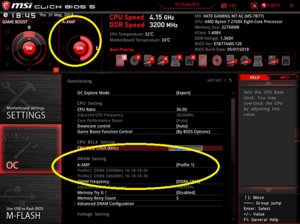
Motherboards and processors that don’t support any overclocking will not support memory overclocking, even if it’s automated via Intel XMP. This includes models that use Intel’s H, B, and Q-series chipsets, as well as Intel’s non-K-series processors. Current “locked” CPUs and motherboards are limited to DDR4-2666, previous-generation parts to DDR4-2400, and the Core i3 (even the “unlocked” version) to DDR4-2400.
Other limitations include motherboards that can’t support the voltage adjustment required by many XMPs, those with poorly-written firmware that won’t set the proper advanced timings to make the system bootable (we’ve seen some boards set zeros for timings not addressed in XMP), and the chance occurrence of receiving a CPU that isn’t stable at normally-achievable overclocks. XMP is an overclocking technology, and support for higher-than-standard data rates isn't guaranteed by the CPU’s manufacturer.
-
CountMike Well, I have an issue with XMP being called Overclock, it's just a suggestion/guide for BIOS to enable some memory settings from one or multiple ones so memory would run at those settings. True OC would be going over XMP settings. As XMP is not definite and for all possible memory settings, there's a lot of space left for even better adjustments depending on MB, BIOS and CPU's IMC.Reply -
Crashman Reply
So, if you buy DDR4-2666 1.2V and set it to DDR4-3200 1.35V, it's an overclock. But, if a memory vendor programs that as an XMP, it's not an overclock. Is that you take?CountMike said:Well, I have an issue with XMP being called Overclock, it's just a suggestion/guide for BIOS to enable some memory settings from one or multiple ones so memory would run at those settings. True OC would be going over XMP settings. As XMP is not definite and for all possible memory settings, there's a lot of space left for even better adjustments depending on MB, BIOS and CPU's IMC.
Technically speaking, overclocking DDR4-2666 to DDR4-3200 is an overclock regardless of how it's done. I understand that calling XMP an overclock diminishes the 1337-ness of overclocking, but those are the breaks.
BTW, several motherboard brands have had auto-overclocking programs for several CPU generations, so perhaps the term has already been diminished? -
CountMike Well, I wouldn't consider XMP as a real overclock but just as a maximum clock (frequency) manufacturer considers as full speed for that particular RAM stick model. That is not a traditional overclock that meant going over manufacturer's recommended frequencies. Some RAM has several such XMP profiles that are just set of instructions for BIOS to set memory to certain frequency including other settings like Cas and voltage for instance for it to work at all or at it's best performance. JEDEC is also similar but may include even more detailed settings.Reply
Conversely, if CPU can run from a set minimum frequency to it's maximum frequency on all cores is also just a set of steps in frequency and not real overclock but just normal operation within given (projected) parameters set by manufacturer to their least successful sample. That's why moist can be "overclocked" to more than that. -
Crashman Reply
The manufacturer of the RAM ICs says it's DDR4-2666. It doesn't matter who pushes it to a higher level, it's still a higher-than-rated clock. The RAM is indeed DDR4-2666 regardless of how the company that puts it on a DIMM advertises it.CountMike said:Well, I wouldn't consider XMP as a real overclock but just as a maximum clock (frequency) manufacturer considers as full speed for that particular RAM stick model. That is not a traditional overclock that meant going over manufacturer's recommended frequencies. Some RAM has several such XMP profiles that are just set of instructions for BIOS to set memory to certain frequency including other settings like Cas and voltage for instance for it to work at all or at it's best performance. JEDEC is also similar but may include even more detailed settings.
Conversely, if CPU can run from a set minimum frequency to it's maximum frequency on all cores is also just a set of steps in frequency and not real overclock but just normal operation within given (projected) parameters set by manufacturer to their least successful sample. That's why moist can be "overclocked" to more than that.
Let me put it this way: Remember when OCZ sold bone-stock Samsung PC-800 RDRAM as PC-1066? And remember that it overheated on most systems? And remember what we said about it back then? You might not have been around back then, but the consensus was "overclocked too far".
Regarding that old memory, Samsung manufactured it. OCZ overclocked it.
Moving up to the present, the memory referenced in this article was originally Samsung DDR4-2666, sold by Adata as DDR4-3200. Samsung manufactured it. Adata overclocked it.
From another angle: If the chips on these modules weren't being overclocked, XMP wouldn't be necessary.
As for CPUs, do you remember when Intel tried to release a Pentium III 1.13GHz using the Coppermine core? And remember the math error? Uncovering that put Tom's Hardware back on the map. Intel had used a raised vCore to get that CPU to that frequency, and the consensus in the enthusiast community was "overclocked too far". But since Intel was the actual IC manufacturer, you could instead say "improperly validated", and that's closer to the argument you're making. -
TJ Hooker Reply
XMP typically means running the RAM faster than what the CPU IMC is rated for (e.g. 2666/2400 MHz for latest Intel chips), and motherboard manufacturers will list any compatible memory speeds beyond this speed as "(OC)".CountMike said:Well, I wouldn't consider XMP as a real overclock but just as a maximum clock (frequency) manufacturer considers as full speed for that particular RAM stick model. That is not a traditional overclock that meant going over manufacturer's recommended frequencies. -
Crashman Reply
Then you're overclocking the IMC though, so the overclocking label applies to a different component.TJ Hooker said:XMP typically means running the RAM faster than what the CPU IMC is rated for (e.g. 2666/2400 MHz for latest Intel chips), and motherboard manufacturers will list any compatible memory speeds beyond this speed as "(OC)".
I didn't want overclocking in the title, mostly because I thought that as a "how to" it would get higher Google placement with the shorter title, but the boss has his own strategy :D -
TJ Hooker Reply
Where do you see the original rated speed of the DRAM chips? Are you just going off the base JEDEC profile that's included?Crashman said:Moving up to the present, the memory referenced in this article was originally Samsung DDR4-2666, sold by Adata as DDR4-3200. Samsung manufactured it. Adata overclocked it. -
TechyInAZ Yeah technically XMP is an overclock. But you could also call it a stock speed in another sense (due to the fact that it is certified to run at that overclocked speed from the memory making company itself.)Reply
Just depends on what your definition of "overclock" is. -
Crashman Reply
Nah, you just peel the heat spreaders off and then when you find torn adhesive all over the place you get embarrassed and don't take photos. More than half the time, more than half the print comes off with the adhesive, and then you can read it with a magnifying glass and a flashlight but can't get a legible photo.TJ Hooker said:Where do you see the original rated speed of the DRAM chips? Are you just going off the base JEDEC profile that's included?
Or you can ask the company. This works pretty well for review sites but they might not respond to individuals.
Or you can use a program. Those are free to individuals
Or you can Google another article where someone either got a decent photo OR used a program, and then have the owner of that program threaten to sue you for not licensing the program even though you don't have a copy.
In all of those cases, you will always find that the top JEDEC (SPD table) configuration is also the set for which the ICs are rated. Always. 100% of the time. Of course we haven't tested every kit on the market, so...prove me wrong?
Tom's Hardware hasn't reviewed any DRAM with IC's over DDR4-2666, so that only leaves overclocking.
